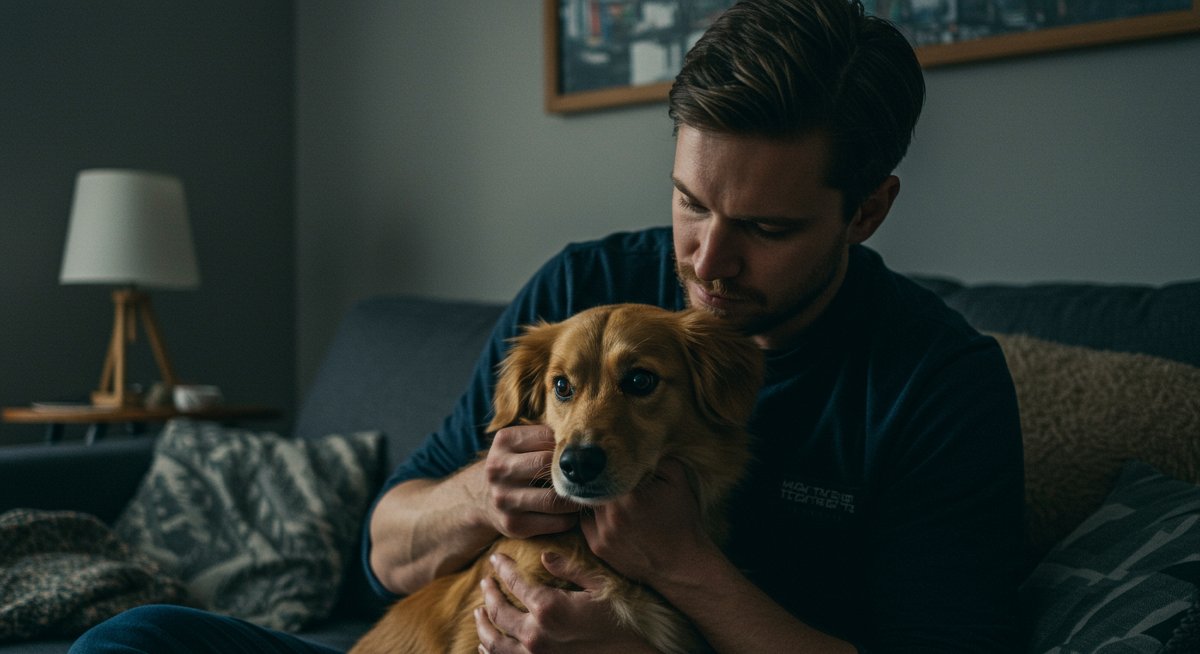As experienced dog parents, you've likely encountered various challenges in caring for your furry companions. Dog anxiety, a common yet often misunderstood issue, can significantly impact your dog's well-being and your relationship. This guide offers a deep dive into recognising, understanding, and effectively managing anxiety in dogs, going beyond basic advice to provide advanced strategies for a calmer, happier life for your beloved pet.

Deep dive into dog anxiety for advanced pet parents
Anxiety in dogs manifests in diverse ways, from mild unease to debilitating phobias. Recognising the subtleties of these behaviours is the first step in providing effective support. While some dogs may exhibit obvious signs like trembling or excessive panting, others might display more subtle cues, such as increased vigilance, changes in appetite, or withdrawn behaviour. In my experience, many pet owners initially misinterpret these signs, which is why a proactive approach is so important.
Here's where it gets interesting. Dog anxiety can stem from a variety of sources. Understanding these causes – including genetics, early life experiences, and environmental factors – is crucial for developing targeted solutions. For instance, a dog with a history of abandonment may experience separation anxiety, while a dog exposed to loud noises might develop noise phobia. Generalized anxiety can also develop, where the dog is anxious in many situations. The key is to become a keen observer of your dog’s behaviour, documenting when and where the anxiety occurs. This information will be very helpful in diagnosing the cause of the anxiety.
Example 1: A golden retriever named Max started exhibiting signs of anxiety, particularly when thunderstorms were predicted. Initially, his owners dismissed it as mere restlessness. However, after observing his behaviour closely – hiding, panting, and refusing to eat – they realised it was a full-blown noise phobia. They then consulted a veterinary behaviourist, who recommended a combination of desensitisation, counterconditioning, and, in severe cases, medication. This tailored approach significantly improved Max’s quality of life.
Example 2: A rescue dog named Luna displayed signs of separation anxiety after being adopted. Her owners noticed she was destructive when left alone, barking incessantly, and exhibiting signs of distress. Recognising the root cause of the anxiety – a fear of abandonment – they implemented a structured desensitisation program. This included short absences, gradually increasing in duration, coupled with positive reinforcement when she remained calm. They also created a “safe space” for her with a comfortable bed and familiar toys, making her feel more secure when they were away.
Example 3: A senior German Shepherd named Kaiser started experiencing anxiety due to cognitive decline. His owners noticed increased pacing, confusion, and restlessness. Recognising the change as a sign of age-related anxiety, they modified his environment to make him more comfortable. They added nightlights, maintained a consistent daily routine, and consulted with their vet, who prescribed medication to manage his cognitive function and anxiety.
Expert Tip: Always consult with a veterinarian or certified dog behaviourist when dealing with dog anxiety. They can provide a professional diagnosis and recommend the best course of treatment.
Advanced strategies and insights
Beyond the basics, advanced strategies for managing dog anxiety involve a multifaceted approach. Consider the following:
Behavior modification techniques: Desensitisation and counterconditioning are powerful tools. Desensitisation involves gradual exposure to the anxiety-provoking stimulus at a low intensity, while counterconditioning associates the stimulus with positive experiences, such as treats or praise. Consistency is key!
Environmental enrichment: Creating a stimulating and secure environment can significantly reduce anxiety. This includes providing plenty of exercise, mental stimulation (e.g., puzzle toys, training sessions), and a comfortable resting area.
Nutritional support: Some dogs benefit from dietary changes or supplements that support brain health and reduce anxiety. Speak with your vet to explore options.
Medication (when necessary): In severe cases, medication prescribed by a veterinarian may be necessary to manage anxiety symptoms. These medications are often used in conjunction with behaviour modification techniques.
Training: Consistent, positive-reinforcement training can boost your dog's confidence and reduce anxiety in many situations. Enroll your dog in advanced obedience classes.
Socialisation: For dogs with fear-based anxiety, properly managed socialisation can help them to become more comfortable in social situations.
Optimising your pet's behavior
Optimising your pet’s behaviour is all about consistency, patience, and understanding. Start with the basics. Ensure your dog receives regular exercise and a balanced diet, which can have a profound impact on their mental well-being. Create a predictable daily routine, as dogs thrive on consistency. The goal here is to make your dog feel safe and secure. Make sure your dog’s “safe space” is always available, such as a crate or bed. It should be a place where your dog can retreat to when feeling stressed.
In my experience, many owners overlook the importance of a consistent routine. Dogs find comfort in the predictability of their day, which helps reduce anxiety.
Another key aspect is to learn your dog's stress signals. These signals can range from lip licking, yawning, and whale eye (showing the whites of the eyes) to more obvious signs like panting or trembling.
Example: Imagine a dog named Buddy, who fears car rides. His owners, recognising the need for a solution, decided to use counterconditioning. They started by simply sitting in the car with Buddy, rewarding him with treats and praise. Next, they started the car, without moving. After a few days, they started driving short distances. Eventually, Buddy learned to associate car rides with positive experiences, dramatically reducing his anxiety.
Common Mistake: Many owners inadvertently reinforce anxious behaviour by trying to comfort their dog during a stressful event. While it’s natural to want to soothe your dog, it can inadvertently reinforce the anxious behaviour. Instead, ignore the behaviour and reward calm behaviour.
Expert Tip: A certified dog behaviorist can provide personalised guidance and support in creating a successful behaviour modification plan.

Case study: Achieving calmness with your anxious dog
Consider the case of Bailey, a Border Collie mix with severe noise phobia. Bailey would become extremely agitated during thunderstorms and fireworks, exhibiting destructive behaviours. His owners consulted a veterinary behaviourist, who developed a comprehensive treatment plan. The plan included:
- Desensitisation: Gradually exposing Bailey to the sounds of thunder and fireworks at a very low volume.
- Counterconditioning: Pairing the sounds with high-value treats, such as pieces of cooked chicken.
- Safe Space: Creating a safe space in a soundproofed room, where Bailey could retreat during storms.
- Medication: Administering anti-anxiety medication prescribed by the vet during predicted events.
Over several months, Bailey's anxiety significantly decreased. He learned to associate the sounds with positive experiences, and his destructive behaviours ceased. Bailey's story highlights the effectiveness of a combined approach.
Navigating complex pet challenges
Some anxiety cases are more complex, requiring a deeper understanding of the underlying issues. Here’s how to navigate these challenges:
Medical Evaluation: Always rule out any underlying medical conditions that could be contributing to the anxiety.
Professional Help: Consult with a veterinary behaviorist or certified dog trainer who has experience in dealing with anxiety.
Patience and Consistency: Remember that behaviour modification takes time and consistency. Don't get discouraged if you don't see results immediately.
Monitor and Adjust: Continuously monitor your dog's progress and be prepared to adjust your approach as needed.
Seek Support: Join a support group or online forum where you can connect with other dog owners who are experiencing similar challenges. You can share experiences and learn from others.
Expert Tip: Consider using a Thundershirt, which applies gentle pressure to help calm anxious dogs. Always introduce it gradually and positively.
Integrating advanced care practices
Integrating advanced care practices involves a commitment to staying informed and proactive. Here's how:
Continued Education: Stay up-to-date on the latest research and techniques in dog behaviour and anxiety management. Consider attending workshops or seminars led by certified professionals.
Regular Veterinary Checkups: Schedule regular veterinary checkups to monitor your dog's overall health and to address any potential medical causes of anxiety.
Environmental Modifications: Evaluate your dog's environment and make any necessary changes to create a calming and secure space. This might include adding comfortable bedding, playing calming music, or using pheromone diffusers.
Mental Stimulation: Continue to provide opportunities for mental stimulation through training, puzzle toys, and interactive games.
Long-term wellness & longevity tips
Long-term wellness and longevity are tied to consistent care. Maintaining a consistent routine is paramount. This includes feeding your dog at the same times each day, providing regular exercise, and ensuring they have adequate rest. A predictable schedule helps reduce anxiety by providing a sense of security.
Regular Exercise: Regular physical activity is key. Exercise helps burn off excess energy, reducing stress and anxiety. Exercise also stimulates the release of endorphins, which have mood-boosting effects. Make sure the exercise matches your dog's breed and energy level.
Enrichment: Mental stimulation is equally important. Provide opportunities for your dog to engage in activities that challenge their mind. Use puzzle toys and interactive games. Rotate toys to keep them interested. Training sessions are an excellent way to challenge their mind.
Socialisation: Socialisation is key for preventing anxiety. For a dog prone to anxiety, controlled socialisation with known, calm dogs is best. Early and positive socialization is essential, but should be managed carefully.
Nutrition: A balanced diet supports physical and mental health. Choose high-quality dog food formulated for your dog’s life stage and activity level. Some supplements, such as omega-3 fatty acids, can also support brain health.
Health Monitoring: Regular vet checkups help to catch any issues early. Routine dental care can prevent dental disease and ensure your dog's comfort. Keep a close eye on your dog’s behaviour and health and report any changes to your vet.
Expert Tip: Consider creating a calming sanctuary in your home, a place where your dog can retreat when feeling overwhelmed. Include a comfortable bed, familiar toys, and calming scents, such as lavender.
Expert-level pet care insights
Taking your dog's anxiety seriously and taking active steps to manage it is a key step toward a better life for both of you. Be patient, persistent, and seek professional guidance when needed. Here are some expert insights:
Behavioral Therapy: Behaviour modification, often done in conjunction with medication, can address the root cause of the anxiety. This may include desensitisation and counterconditioning.
Medication Management: In some cases, your vet may recommend medication to manage anxiety symptoms. These medications are often used in conjunction with behaviour modification techniques. Work with your vet to find the right dosage.
Environmental Control: Create a calm and predictable environment. This involves minimising stressors, providing a safe space, and maintaining a consistent routine.
Owner Education: The more you know about dog anxiety, the better you can support your dog. Read books, attend workshops, and consult with experts.
Early Intervention: The sooner you address your dog’s anxiety, the better the outcome will be. Don't delay seeking help.
Professional Guidance: Don’t hesitate to seek professional help from a certified dog behaviorist or veterinarian specializing in behavior.
By implementing these strategies and staying committed to your dog's well-being, you can help them live a happier, healthier, and less anxious life. If you are on this journey too, I'd love to hear how it goes for you.